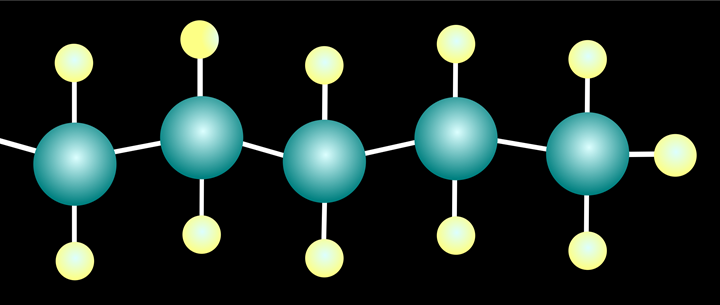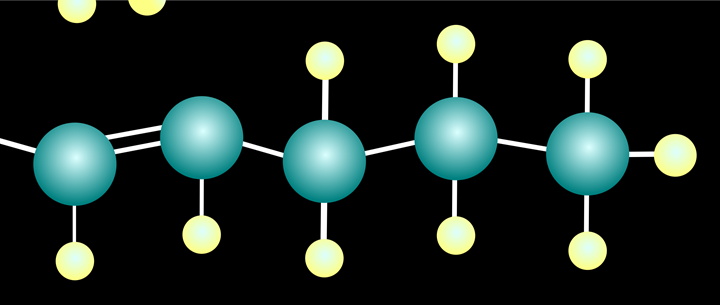
Waste Plastics Must D-I-E
Consumer concern over plastic waste has driven demand for recycled plastic upwards, while supply has struggled to keep pace. Improved collection infrastructure and changing behaviors can have immediate impact on the achievement of recycled content goals. In the long term, the development of new recycling technologies can contribute by expanding the breadth of collected recyclables that can be processed into useful material.
Recently published research describes methods for using waste polyethylene to create propene, the building block monomer for polypropylene, possibly facilitating recycling of the most commonly produced plastic into the second-most.

A very simple carbon chain, saturated with hydrogen.
Producing high-value plastic feedstock from PE requires breaking the strong carbon-carbon bonds that form the polymer backbone. Currently, the most common process for doing this is pyrolysis, smashing this bonds with extreme heat. Pyrolysis can create oils and new monomer from plastic wastes, but the high temperature requirements result in a large greenhouse-gas footprint.
Many alternatives are being investigated by companies and by academic researchers. Variations on a particular approach have generated some buzz in recent weeks. It starts with the use of a catalyst to pull hydrogen atoms off the carbon chain, creating a single double bond (dehydrogenation).

Dehydrogenation leaves PE with at least one double bond.

Isomerization reactions change the position of the double bond.
Finally, the carbon chain is cut in two by reaction with ethylene, forming a smaller hydrocarbon. I’ve chosen to illustrate a simple case here that is simple and gives us exactly what we want: propene. Of course, in a real process propene would be just one of many products, and reducing that variation is one of the challenges.

Here the propene molecule has been split off from the chain by ethylene.
In the journal Science, a group from UC Berkeley (Conk et. Al) described the results of using various catalysts to break down both virgin and postconsumer HDPE and LDPE into propene. The reported yields were up to 80%, and the processing temperatures much lower than pyrolysis.
In the Journal of the American Chemical Society, a collaboration between scientists at the University of California, the University of Illinois at Urbana-Champaign, and the Dow Chemical Company published the results of their research, describing tandem processes to convert PE into propene monomer, conducting dehydrogenation, isomerization, and ethenolysis simultaneously. A preliminary carbon footprint analysis showed a modest reduction in greenhouse gas emissions relative to conventional propylene production. But, as the authors point out, much larger emissions reductions could be achieved by using renewable electricity and by sourcing ethylene sustainably.
Also in the Journal of the American Chemical Society, Zichittella et. Al recently described the use of cobalt-based catalysts for dehydrogenation of PE and PP to create propane. Itself a useful hydrocarbon, propane can also be used to create new polyolefins. Colbalt-based catalysts were selected to avoid the use of precious metals like platinum, while generating the desired low-weight hydrocarbons without too much methane. The research team concluded that colbalt combined with a zeolite performed the best in terms of weight selectivity and may have future utility in the processing of postconsumer HDPE, PP, and LDPE.
Read: 50 Years…600 Issues…and Still Counting
Each of the three studies expands the available knowledge, looking at different combinations of catalysts and conditions to try and address the problems of cost and energy while achieving high yield of valuable recyclate from PE that has reached the end of its useful life.
It may be some years before we see a process like these at work on an industrial scale, but in the meantime I will be interested to watch and learn as chemists try out different approaches. There is a lot of polyethylene in the world that is no longer usable, likely to be a whole lot more in the very near future, and turning it in to something as useful as new PP would be no small feat.

Leave a Reply